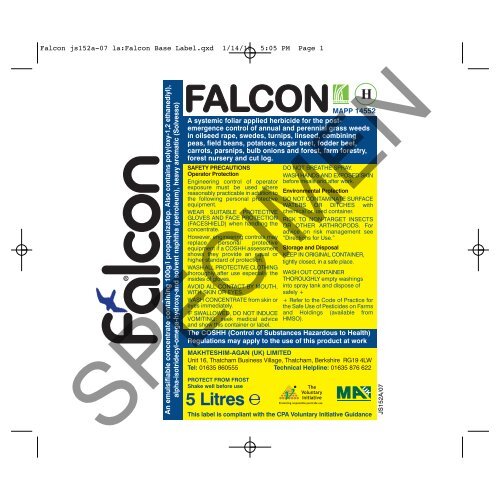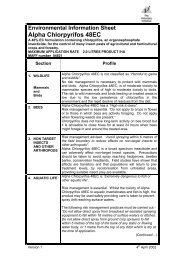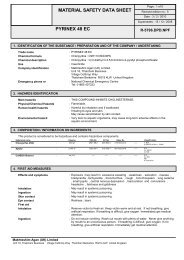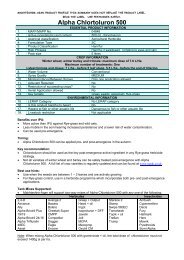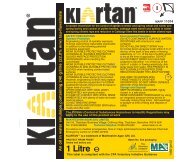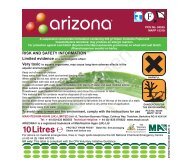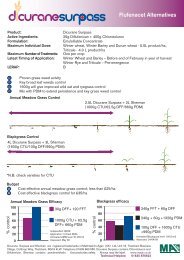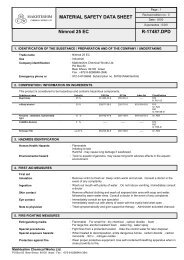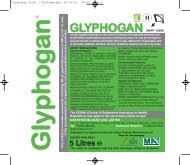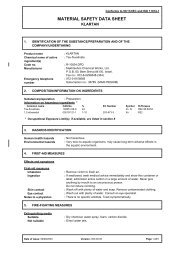Create successful ePaper yourself
Turn your PDF publications into a flip-book with our unique Google optimized e-Paper software.
Falcon js152a-07 la:Falcon Base Label.qxd 1/14/10 5:05 PM Page 1<br />
An emulsifiable concentrate containing 100g/l propaquizafop. Also contains poly(oxy-1,2 ethanediyl),<br />
alpha-isotridecyl-omega-hydroxy-and solvent naphtha (petroleum), heavy aromatic (Solvesso)<br />
<strong>FALCON</strong><br />
HERBICIDE<br />
A systemic foliar applied herbicide for the postemergence<br />
control of annual and perennial grass weeds<br />
in oilseed rape, swedes, turnips, linseed, combining<br />
peas, field beans, potatoes, sugar beet, fodder beet,<br />
carrots, parsnips, bulb onions and forest, farm forestry,<br />
forest nursery and cut log.<br />
<strong>FALCON</strong>MAPP 14552<br />
SAFETY PRECAUTIONS<br />
DO NOT BREATHE SPRAY.<br />
Operator Protection<br />
WASH HANDS AND EXPOSED SKIN<br />
Engineering control of operator before meals and after work.<br />
exposure must be used where<br />
reasonably practicable in addition to Environmental Protection<br />
the following personal protective DO NOT CONTAMINATE SURFACE<br />
equipment.<br />
WATERS OR DITCHES with<br />
WEAR SUITABLE PROTECTIVE chemical or used container.<br />
GLOVES AND FACE PROTECTION RISK TO NON-TARGET INSECTS<br />
(FACESHIELD) when handling the OR OTHER ARTHROPODS. For<br />
concentrate.<br />
advice on risk management see<br />
However, engineering controls may “Directions for Use.”<br />
replace personal protective<br />
equipment if a COSHH assessment Storage and Disposal<br />
shows they provide an equal or KEEP IN ORIGINAL CONTAINER,<br />
higher standard of protection. tightly closed, in a safe place.<br />
WASH ALL PROTECTIVE CLOTHING<br />
thoroughly after use especially the WASH OUT CONTAINER<br />
insides of gloves.<br />
THOROUGHLY empty washings<br />
AVOID ALL CONTACT BY MOUTH, into spray tank and dispose of<br />
WITH SKIN OR EYES.<br />
safely +<br />
WASH CONCENTRATE from skin or + Refer to the Code of Practice for<br />
eyes immediately.<br />
the Safe Use of Pesticides on Farms<br />
IF SWALLOWED, DO NOT INDUCE and Holdings (available from<br />
VOMITING: seek medical advice HMSO).<br />
and show this container or label.<br />
The COSHH (Control of Substances Hazardous to Health)<br />
Regulations may apply to the use of this product at work<br />
MAKHTESHIM-AGAN (UK) LIMITED<br />
Unit 16, Thatcham Business Village, Thatcham, Berkshire RG19 4LW<br />
Tel: 01635 860555 Technical Helpline: 01635 876 622<br />
PROTECT FROM FROST<br />
Shake well before use<br />
SPECIMEN<br />
5 Litres<br />
The<br />
Voluntary<br />
Initiative<br />
Promoting responsible pesticide use<br />
H<br />
This label is compliant with the CPA Voluntary Initiative Guidance<br />
JS152A/07
Falcon Booklet 140X145mm.qxd 13/12/09 21:55 Page 1<br />
This leaflet/booklet is part of the approved product label<br />
IMPORTANT INFORMATION<br />
FOR USE ONLY AS AN AGRICULTURAL HORTICULTURAL AND FORESTRY HERBICIDE<br />
Maximum Maximum number Latest time of application<br />
Crops/situation individual dose of applications<br />
Field bean, Oilseed rape (winter), Linseed 1.5 L product/ha One per crop Before flower buds visible stage<br />
Oilseed rape (spring) 1.5 L product/ha One per crop Before eight fully<br />
expanded leaves stage<br />
Sugar beet, Fodder beet, Potato (maincrop), 1.5 L product/ha One per crop 8 weeks before harvest<br />
Swede, Turnip<br />
Potato (early), Carrot, Parsnip, Bulb onion 1.5 L product/ha One per crop 4 weeks before harvest<br />
Combining pea 1.5 L product/ha One per crop 7 weeks before harvest<br />
Forest, Farm forestry, Forest nursery, Cut log 1.5 L product/ha One per year -<br />
Other specific restrictions:<br />
To avoid the build up of resistance do not apply products containing an ACCase inhibitor herbicide more than twice to any<br />
crop. In addition, do not use this product in mixture or sequence with any other product containing propaquizafop.<br />
READ THE LABEL BEFORE USE. USING THIS PRODUCT IN A MANNER THAT IS<br />
INCONSISTENT WITH THE LABEL MAY BE AN OFFENCE. FOLLOW THE CODE OF PRACTICE<br />
FOR USING PLANT PROTECTION PRODUCTS<br />
<strong>FALCON</strong> MAPP 14544<br />
An emulsifiable concentrate containing 100g/l propaquizafop. Also contains poly(oxy-1,2 ethanediyl), alpha-isotridecylomega-hydroxy-and<br />
solvent naphtha (petroleum), heavy aromatic (Solvesso)<br />
RISK OF SERIOUS DAMAGE<br />
TOXIC TO AQUATIC<br />
TO EYES<br />
ORGANISMS, MAY CAUSE<br />
HARMFUL BY INHALATION<br />
LONG-TERM ADVERSE<br />
EFFECTS IN THE AQUATIC<br />
ENVIRONMENT<br />
HARMFUL<br />
DANGEROUS FOR<br />
AVOID CONTACT WITH EYES<br />
THE ENVIRONMENT<br />
IN CASE OF CONTACT WITH THE EYES, RINSE IMMEDIATLEY WITH PLENTY OF WATER AND<br />
SEEK MEDICAL ADVICE. KEEP OUT OF REACH OF CHILDREN<br />
KEEP AWAY FROM FOOD, DRINK AND ANIMAL FEEDING STUFFS<br />
DO NOT BREATHE SPRAY. WEAR EYE/FACE PROTECTION<br />
THIS MATERIAL AND ITS CONTAINER MUST BE DISPOSED OF IN A SAFE WAY<br />
USE APPROPRIATE CONTAINMENT TO AVOID ENVIRONMENTAL CONTAMINATION<br />
TO AVOID RISKS TO MAN AND THE ENVIRONMENT, COMPLY WITH THE INSTRUCTIONS FOR USE<br />
SPECIMEN
Falcon Booklet 140X145mm.qxd 13/12/09 21:55 Page 2<br />
SAFETY PRECAUTIONS<br />
Operator Protection<br />
Engineering control of operator exposure must be used where reasonably practicable in addition to the following<br />
personal protective equipment.<br />
WEAR SUITABLE PROTECTIVE GLOVES AND FACE PROTECTION (FACESHIELD) when handling the concentrate.<br />
However, engineering controls may replace personal protective equipment if a COSHH assessment shows they provide<br />
an equal or higher standard of protection.<br />
WASH ALL PROTECTIVE CLOTHING thoroughly after use especially the insides of gloves.<br />
AVOID ALL CONTACT BY MOUTH, WITH SKIN OR EYES. WASH CONCENTRATE from skin or eyes immediately.<br />
IF SWALLOWED, DO NOT INDUCE VOMITING: seek medical advice and show this container or label.<br />
DO NOT BREATHE SPRAY. WASH HANDS AND EXPOSED SKIN before meals and after work.<br />
Environmental Protection<br />
DO NOT CONTAMINATE SURFACE WATERS OR DITCHES with chemical or used container.<br />
RISK TO NON-TARGET INSECTS OR OTHER ARTHROPODS. For advice on risk management see “Directions for Use.”<br />
Storage and Disposal<br />
KEEP IN ORIGINAL CONTAINER, tightly closed, in a safe place.<br />
WASH OUT CONTAINER THOROUGHLY empty washings into spray tank and dispose of safely +<br />
+ Refer to the Code of Practice for the Safe Use of Pesticides on Farms and Holdings (available from HMSO).<br />
DIRECTIONS FOR USE<br />
IMPORTANT: This information is approved as part of the Product Label. All instructions within this section must be<br />
read carefully in order to obtain safe and successful use of this product.<br />
<strong>FALCON</strong> is a systemic foliar applied herbicide for post-emergence control of annual and perennial grass weeds in oilseed<br />
rape, swedes, turnips, linseed, combining peas, field beans, potatoes, sugar beet, fodder beet, carrots, parsnips, bulb<br />
onions and forest, farm forestry, forest nursery and cut log. Weeds must be emerged at the time of application.<br />
1. RESTRICTIONS<br />
<strong>FALCON</strong> is foliar acting and the dose is therefore independent of soil type.<br />
Avoid spraying within six metres of the field boundary to reduce effects on non-target insects or other arthropods.<br />
Avoid overlaps.<br />
Peas and Beans - If <strong>FALCON</strong> is applied during periods of high temperatures and/or low soil moisture content chlorotic<br />
spotting of the crop may result, particularly on combining peas and field beans, but there is no adverse effect on<br />
subsequent growth or yield of combining peas.<br />
Carrots, Parsnips and Onions - Crop effects can occur when the couch dose is applied at early growth stages in<br />
carrots, parsnips and onions.<br />
Potatoes - <strong>FALCON</strong> must not be applied to seed crops. Crops suffering from frost damage should not be treated.<br />
Forestry - This covers all forestry situations including forest nursery, commercial forests, farm forests and cut logs.<br />
<strong>FALCON</strong> may be applied by tractor mounted/drawn sprayer or knapsack sprayer as an overall or band treatment in all<br />
forestry situations. The sprayer should be calibrated to apply 200-250 l/ha as a FINE or MEDIUM spray (as defined by<br />
BCPC).<br />
SPECIMEN
Falcon Booklet 140X145mm.qxd 13/12/09 21:55 Page 3<br />
The following tree specimens are tolerant to <strong>FALCON</strong> at any interval after planting when dormant or in leaf:<br />
Conifers<br />
Broad Leaved Trees<br />
Sitka spruce Norway spruce Oak Alder Wild cherry<br />
Douglas fir Noble fir Ash Sweet chestnut Horse chestnut<br />
Corsican pine Western red cedar Sycamore Poplar Birch<br />
Japanese larch Scots pine Beech Willow Maple<br />
Resistance Warning<br />
Strains of some annual grasses (e.g. Black-grass, Wild-Oats and Italian Rye-grass) have developed resistance to herbicides<br />
which may lead to poor control. A strategy for preventing and managing such resistance should be adopted. Guidelines<br />
have been produced by the Weed Resistance Action group and copies are available from the HGCA, CPA, your distributor,<br />
crop advisor or product manufacturer. This product contains propaquizafop which is an ACCase inhibitor, also classified by the<br />
Herbicide Resistance Action Committee as ‘Group A’.<br />
Use only as part of a resistance management strategy that includes cultural methods of control and does not use ACCase<br />
inhibitors as the sole chemical method of grass-weed control.<br />
Applying a second product containing an ACCase inhibitor to a crop will increase the risk of resistance development, only<br />
use a second ACCase inhibitor to control different weeds at a different timimg.<br />
2. WEED CONTROL<br />
Speed of kill will be more rapid when weeds are growing actively under warm conditions with adequate moisture.<br />
Treatment under cool conditions will give slower activity. In poor conditions use the higher dose.<br />
Weeds germinating after application will NOT be controlled. Broad-leaved weeds will NOT be controlled.<br />
The following weeds are controlled up to growth stages indicated at the dose indicated:<br />
Weed Weed Growth Stage Dose (1) Litre product/ha<br />
Volunteer wheat and barley Optimum: 2 leaves unfolded to end of tillering. 0.7 or 1.0<br />
Latest: Stem erect<br />
Blackgrass Optimum: 2 leaves unfolded to stem erect 0.7 or 1.0<br />
Latest: Booting<br />
Wild oats Optimum: 2 leaves unfolded to early tillering 0.7 or 1.0<br />
Latest: Stem erect<br />
Barley cover crops (2) Optimum: 2 leaves unfolded to stem erect 1.0 or 1.2<br />
Latest: 2nd node detectable<br />
Rye-grass (from seed) Optimum: 2 leaves unfolded to early tillering 1.2<br />
Latest: Before stem erect<br />
Common couch 3 leaves unfolded (when majority of shoots have 1.5<br />
emerged and are approx. 15 cm tall)<br />
Sterile brome Optimum: 2 expanded leaves to fully tillered 0.7 to 1.0<br />
SPECIMEN<br />
Notes:<br />
(1) Use highest dose specified if weeds are beyond optimum growth stage or under the following conditions:<br />
• Poor growing conditions, e.g. cool temperatures, dry soil<br />
• Overwintered weeds<br />
• Severe weed infestations especially in non-competitive crops e.g. sugar beet, onions and thin crops of oilseed rape
Falcon Booklet 140X145mm.qxd 13/12/09 21:55 Page 4<br />
(2) Barley cover crops: spray when risk of wind blow has passed and before there is serious competition with the<br />
crop. Use the higher dose of 1.2 l/ha if spraying is late.<br />
Annual Meadow Grass<br />
Growth will be checked at doses of 0.7 - 1 l/ha and severely checked at 1.5 l/ha. These effects will be reduced if annual<br />
meadow-grass is beyond 3 leaves unfolded stage at spraying.<br />
CROP SPECIFIC INFORMATION<br />
<strong>FALCON</strong> may be applied to the following crops as indicated:<br />
Crop * Start Spraying when the Crop Stop Spraying (PHI - Pre-Harvest Interval)<br />
is at the following GS<br />
Oilseed Rape, winter Expanded cotyledons** Before flower buds visible stage.<br />
Oilseed Rape, spring Expanded cotyledons** Before 8 fully expanded leaves stage<br />
Swedes, Turnips 2 pairs of leaves Before weeds are covered by the crop (PHI = 8 weeks)<br />
Linseed 3 leaves Before flower buds visible stage<br />
Peas, combining 2 pairs of leaves (3 rd node) At flower buds visible stage (PHI = 7 weeks)<br />
Field Beans, winter 4 pairs of leaves Before flower bud visible stage (PHI = 14 weeks)<br />
Field Beans, spring 2 pairs of leaves Before flower bud visible stage (PHI = 14 weeks)<br />
Potatoes 15-20cm high Before weeds are covered by the crop<br />
(Do not treat seed crops)<br />
(PHI - 8 weeks maincrop: 4 weeks earlies)<br />
Sugar Beet, Fodder Beet 2 true leaves Before weeds are covered by the crop (PHI = 8 weeks)<br />
Carrots, Parsnips 1 true leaf PHI = 4 weeks<br />
Onions, bulb Immediately post crook PHI = 4 weeks<br />
Forestry<br />
See Forestry Section<br />
*See Crop Notes below.<br />
**1.5 l/ha (the common couch dose) must not be applied to crops of winter and spring oilseed rape before the 5 leaf<br />
stage of the crop.<br />
CROP NOTES<br />
Avoid overlaps.<br />
Succeeding Crops<br />
If a crop treated with <strong>FALCON</strong> should fail for any reason, or after normal harvest, the minimum intervals listed must be<br />
observed before replanting any of the following crops:<br />
Winter wheat, winter barley 2 weeks Peas and field beans and Winter oilseed rape 4 weeks<br />
Winter oats 16 weeks Ryegrass 8 weeks<br />
SPECIMEN
Falcon Booklet 140X145mm.qxd 13/12/09 21:55 Page 5<br />
3. MIXING AND APPLICATION<br />
MIXING AND APPLICATION<br />
<strong>FALCON</strong> should be applied as a FINE or MEDIUM spray (as defined by BCPC) in 100-200 litres water per hectare. Tank<br />
mixing with adjuvants is not required or recommended. Good spray cover is essential for good results.<br />
Use the higher spray volume in dense crop or weed situations.<br />
Fill the spray tank with half the required volume of clean water and start agitation. Add the required amount of <strong>FALCON</strong><br />
and fully disperse. Add the remainder of the water and continue agitation until spraying is completed. Spray<br />
immediately after mixing.<br />
Sprayers should be thoroughly cleaned before use and filters and nozzles checked for damage and blockage.<br />
<strong>FALCON</strong> may be applied by tractor mounted/drawn sprayer or knapsack sprayer as an overall or band treatment in forest,<br />
farm forestry, forest nursery and cut log. The sprayer should be calibrated to apply 200-250 l/ha as a FINE or MEDIUM<br />
spray (as defined by BCPC).<br />
For knapsack sprayers:<br />
Half fill the sprayer tank with clean water. Add the measured amount of product, with rinsings, to the sprayer tank and<br />
fit the lid. Gently shake the sprayer, by rocking, to ensure thorough mixing. Top up the tank with water to the correct<br />
level. Refit the tank lid and again gently shake the sprayer, by rocking, to ensure thorough mixing.<br />
CONDITIONS OF SUPPLY<br />
All goods supplied by us are of high grade and we believe them to be suitable, but as we cannot exercise control over<br />
their storage, handling, mixing or use, or the weather conditions before, during and after application which may affect<br />
the performance of the goods, all conditions and warranties, statutory or otherwise, as to the quality of fitness for any<br />
purpose of our goods are excluded, and no responsibility will be accepted by us or re-sellers for any failure in<br />
performance, damage or injury whatsoever arising from their storage, handling application or use. These conditions<br />
cannot be varied by our staff or agents whether or not they supervise or assist in the use of such goods.<br />
MATERIAL SAFETY DATA SHEET<br />
<strong>FALCON</strong> MAPP 14551<br />
This Safety Data Sheet does not form part of the product label approved<br />
under the Control of Pesticides Regulations 1986<br />
1. IDENTIFICATION OF THE SUBSTANCE / PREPARATION AND OF THE COMPANY / UNDERTAKING<br />
Trade name<br />
: <strong>FALCON</strong><br />
Chemical description : Propaquizafop: 2-isopropylideneamino-oxyethyl (R)-2-[4-(6-chloroquinoxalin-2-<br />
yloxy)phenoxy]propionate<br />
Use<br />
: Herbicide<br />
Company identification : <strong>Agan</strong> Chemical Manufacturers Ltd. P.O.Box 262, Ashdod, Israel.<br />
MSDS@ma-industries.com<br />
Emergency telephone : +972-8-8515211<br />
SPECIMEN
Falcon Booklet 140X145mm.qxd 13/12/09 21:55 Page 6<br />
2. HAZARDS IDENTIFICATION<br />
Human health hazards Risk of serious damage to eyes.<br />
Environmental hazard Toxic to aquatic organisms, may cause long-term adverse effects in the aquatic<br />
environment.<br />
3. COMPOSITION/INFORMATION ON INGREDIENTS<br />
Substance name Values CAS No. EC No. Index No. Classification<br />
Propaquizafop 9.1 - 10.3% 111479-05-1 - - R43 N; R50-53<br />
Poly(oxy-1,2-ethanediyl)alpha- 30 - 40% 9043-30-5 - - Xn; R22 Xi; R41<br />
isotridecyl-omega-hydroxy-<br />
1,2 Propanediol carbonate 9 - 10% 108-3-7 203-572-1 607-194-00-1 Xi; R36<br />
Kerosine: solvent naptha 35 - 42% 64742-94-5 265-198-5 649-424-00-3 Xn; R65<br />
heavy aromatic<br />
4. FIRST AID MEASURES<br />
: Remove victim to fresh air. If breathing difficult: artificial respiration.<br />
Get medical attention.<br />
Ingestion<br />
: Wash out mouth with plenty of water. Never give anything by mouth to an<br />
unconscious person. Get medical attention.<br />
Skin contact<br />
: Remove contaminated clothing and shoes. Wash away remainder with plenty of water.<br />
Eye contact<br />
: Wash out with plenty of water with the eyelid held wide open for at least 15 minutes.<br />
Get medical attention.<br />
Notes to physician : No specific antidote known. Treat symptomatically and give supportive therapy.<br />
Protection of first-aiders : Use appropriate protection (see section 8).<br />
5. FIRE-FIGHTING MEASURES<br />
Extinguishing media suitable : For small fire : dry chemical powder , water spray carbon dioxide.<br />
For large fire : foam , water fog , water spray.<br />
Special exposure hazards : Flashback may occur along vapour trail.<br />
Hazardous decomposition : Chloride compounds carbon oxides (CO, CO2) sulfur oxides, nitrogen oxides.<br />
products<br />
Protection of fire-fighters : Self-contained breathing apparatus and total protection required in enclosed areas.<br />
6. ACCIDENTAL RELEASE MEASURES<br />
Personal precautions : Wear suitable protective clothing, gloves and eye/face protection.<br />
Environmental precautions : Do not empty into drains Do not discharge into the environment.<br />
After spillage and/or leakage : Absorb in sand or other inert material. Collect spills and put it into appropriated<br />
container. Dispose of this material and its container at hazardous or special waste<br />
collection point.<br />
SPECIMEN<br />
7. HANDLING AND STORAGE<br />
Handling<br />
: Ventilation required.<br />
Storage<br />
: Keep in original containers. Keep away from food, drink and animal feeding<br />
stuffs. Store in dry, well-ventilated area.<br />
Precautions in handling : Handle in accordance with good industrial hygiene and safety procedures.<br />
and storage
Falcon Booklet 140X145mm.qxd 13/12/09 21:55 Page 7<br />
8. EXPOSURE CONTROLS / PERSONAL PROTECTION<br />
Engineering measures Ventilation required.<br />
Industrial hygiene Wash hands thoroughly after handling. When using do not eat, drink or smoke.<br />
Wash clothing before re-using.<br />
Respiratory protection Wear suitable respiratory equipment.<br />
Skin protection<br />
Wear suitable protective clothing Wear safety boots.<br />
Hand protection<br />
Wear suitable gloves.<br />
Eye protection<br />
Chemical goggles or safety glasses.<br />
Occupational Exposure Limits Propaquizafop: No data available.<br />
TLV [mg/m3]<br />
Solvent Naphta: 52 or 10 ppm<br />
9. PHYSICAL AND CHEMICAL PROPERTIES<br />
Physical state<br />
: Liquid<br />
Colour<br />
: Yellow - orange<br />
Odour<br />
: Aromatic<br />
pH value undiluted : 5-8 (1%-Water)<br />
Melting Point (°C) : 66.3 (Propaquizafop)<br />
Density [g/ml]<br />
: 1.04 ± 0.015@20˚C<br />
Vapour pressure [mPa] : 4.4 e-7 @25˚C (Propaquizafop)<br />
Solubility in water : Miscible<br />
Flash point [°C] : >79<br />
Auto-ignition temperature [°C]: 354<br />
Surface tension mN/m : 34.1@25°C<br />
Log P octanol/water : 4.78@25°C (propaquizafop)<br />
Flammability<br />
: Not flammable<br />
Explosion properties : Not explosive<br />
Oxidation properties : Not oxidising<br />
10. STABILITY AND REACTIVITY<br />
Stability<br />
: Stable under normal conditions.<br />
Hazardous decomposition : Chloride compounds , carbon oxides (CO, CO2) nitrogen oxides.<br />
products<br />
Hazardous Polymerization : Will not occur.<br />
Materials to avoid : Oxidizing agents, acids and alkali.<br />
11. TOXICOLOGICAL INFORMATION<br />
Rat ora lLD 50 [mg/kg] : >2000<br />
Rat dermal LD 50 [mg/kg] : >2000<br />
Rat inhalationl LC 50 [mg/l/4h]: 5.15<br />
Dermal irritation (rabbit) : Not irritant<br />
Eyes irritation (rabbit) : Irritant<br />
Sensitization<br />
: Non sensitizer<br />
SPECIMEN
Falcon Booklet 140X145mm.qxd 13/12/09 21:55 Page 8<br />
Carcinogenicity<br />
Propaquizafop<br />
EU: Not classified<br />
Mutagenicity<br />
Propaquizafop: Not mutagenic<br />
Reproductive toxicity Propaquizafop: Not considered to be toxic for the reproductive system<br />
Teratogenicity<br />
Propaquizafop: Not teratogenic in animal experiments<br />
12. ECOLOGICAL INFORMATION<br />
96 H-LC 50 -Rainbow trout [mg/l] 6.53<br />
48 H- EC 50 Dahnia magna [mg/l] 12.9<br />
72 H EC 50 Algae [mg/l] 2.99<br />
LD 50 Birds [mg/l] Propaquizafop: Japanese quail >2,000<br />
Bees-LD 50 -[µg/Bee] Propaquizafop: Not toxic to bees<br />
Persistence and degradability Propaquizafop: Soil : The product is not persistent. Half-life time (t1/2) : 15-26 days.<br />
Propaquizafop: Water : Half-life time (t1/2) (Water/sediment)
Falcon Booklet 140X145mm.qxd 13/12/09 21:55 Page 9<br />
R Phrase(s)<br />
S Phrase(s)<br />
: R41: Risk of serious damage to eyes.<br />
: R51/53 : Toxic to aquatic organisms, may cause long-term adverse effects in the<br />
aquatic environment.<br />
: S2: Keep out of the reach of children.<br />
: S13: Keep away from food, drink and animal feedingstuffs.<br />
: S26: In case of contact with eyes, rinse immediately with plenty of water and seek<br />
medical advice.<br />
: S24/25: Avoid contact with skin and eyes.<br />
: S29/35: Do not empty into drains; dispose of this material and its container in a<br />
safe way.<br />
: S46: If swallowed, seek medical advice immediately and show this container or<br />
label.<br />
: S57: Use appropriate containment to avoid environmental contamination.<br />
: S61: Avoid release to the environment. Refer to special instructions/Safety data<br />
sheets.<br />
16. OTHER INFORMATION<br />
Text of R-phrases in heading 3<br />
R22: Harmful if swallowed.<br />
R36: Irritating to eyes.<br />
R41: Risk of serious damage to eyes.<br />
R43:; May cause sensitization by skin contact.<br />
R50/53: Very toxic to aquatic organisms, may cause long-term adverse effects in the<br />
aquatic environment.<br />
R65: Harmful : may cause lung damage if swallowed.<br />
Print date 22/7/2009<br />
DISCALIMER OF LIABILITY: The information in this Safety Data sheet was obtained from sources which believe are<br />
reliable. However, the information is provided without any warranty, express or implied, regarding its correctness. The<br />
conditions or methods of handling, storage, use or disposal of the product are beyond our control and may be beyond<br />
our knowledge. For this and other reasons, we do not assume responsibility and expressly disclaim liability for loss,<br />
damage or expense arising out of or in any way connected with the handling, storage, use or disposal of the product.<br />
This MSDS was prepared and is to be used only for this product. If the product is used as a component in another<br />
product, this MSDS information may not be applicable<br />
SPECIMEN


